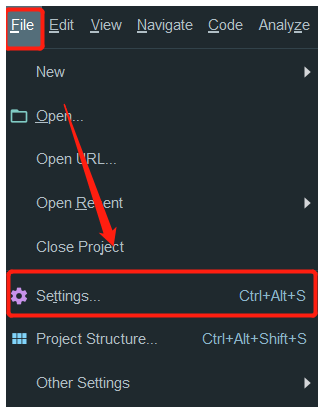
Lombok是什么
引用Lombok官方文档的解释:
Project Lombok is a java library that automatically plugs into your editor and build tools, spicing up your java.
Never write another getter or equals method again, with one annotation your class has a fully featured builder, Automate your logging variables, and much more.
From:https://projectlombok.org/
Lombok项目是一个可以自动插入编辑器和构建工具的Java库,且无需额外再写getter或者equals方法,通过注释的方式使类有一个功能齐全的生成器,自动化日志记录变量等等。
简单说,Lombok可以在编译时为bean自动生成getter/setter、equals、toString等方法。
Lombok的安装
¶Lombok在Maven中的安装
在pom中引入Lombok依赖:
1 | <dependencies> |
¶Lombok插件安装
单单在pom中引入依赖使用Lombok会使得IDE报错,我们需要为IDE加入Lombok插件,以IDEA为例:
点击菜单栏的File -> Settings

在弹出的Settings菜单栏中,选中plugins,在Marketplace中搜索lombok,看到Lombok插件,点击Install即可完成安装

Lombok的使用
Lombok常用的注解如下表所示:
| # | 注解名 | 用途 |
|---|---|---|
| 1 | @Data |
生成getter/setter、equals、canEqual、hashCode、toString方法 |
| 2 | @Getter |
生成getter方法 |
| 3 | @Setter |
成setter方法 |
| 4 | @NonNull |
属性不能为空 |
| 5 | @NoArgsConstructor |
生成无参构造方法 |
| 6 | @RequiredArgsConstructor |
生成部分参数构造方法 |
| 7 | @AllArgsConstructor |
生成全参数构造方法 |
| 8 | @ToString |
生成toString方法 |
| 9 | @Value |
生成含所有参数的构造方法,getter、equals、hashCode、toString方法 |
¶@Data
@Data注解用于Bean上,可为Bean的所有属性自动生成getter/setter、equals、canEqual、hashCode、toString方法,如为final属性,则不会为该属性生成setter方法。注意,@Data并不会自动生成无参构造方法,如果使用了有参构造,则需要手动添加无参构造或者使用@NoArgsConstructor来生成无参构造,示例如下:
1 |
|
编译后User.class文件会是如下所示:
1 | public class User { |
¶@Getter / @Setter
相比@Data注解,在Bean属性上使用的@Getter/@Setter注解更加细粒度,它会为注解属性生成getter/setter方法,示例如下:
1 | public class User { |
编译后User.class文件会是如下所示:
1 | public class User { |
¶@NonNull
使用@NonNull注解的属性不能为null。当使用@NonNull注解于一个属性上的时候,将会为该属性生成一个带有非空检查的setter方法,当调用该setter方法存入null的时候,将会抛出NullPointerException。此外,如果使用Lombok生成带有该参数的构造方法,Lombok会在构造方法中对该参数进行非空校验,代码示例如下:
1 | public class User { |
编译后User.class文件会是如下所示:
1 | public class User { |
¶@NoArgsConstructor / @RequiredArgsConstructor / @AllArgsConstructor
@NoArgsConstructor注解用于类上,使用该注解的类可以生成无参构造方法,同理,@AllArgsConstructor则是带所有参数构造方法。而@RequiredArgsConstructor则是生成使用了@NonNull注解和以final修饰的未经初始化的属性的构造方法,在下面的示例中,@RequiredArgsConstructor只会生成一个含有id属性与username属性的构造方法。
在这里,@NoArgsConstructor的意义主要是与其他两个注解配合使用,因为在使用其他两个注解后会覆盖原有生成的无参构造方法。
1 |
|
编译后User.class文件会是如下所示:
1 | public class User { |
¶@ToString
@toString注解使用在类上,可以为该类生成包含类名、所有属性(会按照属性定义顺序)并用逗号分割的toString方法。示例如下:
1 |
|
编译后User.class文件会是如下所示:
1 | public class User { |
@toString注解还有几个可选属性,通过exclude属性可以排除掉toString方法中的指定字段,includeFieldNames属性来控制输出中是否包含的属性名称,示例如下:
1 | (exclude = "id") |
编译后User.class文件会是如下所示:
1 | public class User { |
¶@Value
@Value注解用在类上,生成含所有参数的构造方法,getter、equals、hashCode、toString方法,但没有setter方法,示例如下:
1 |
|
编译后User.class文件会是如下所示:
1 | public final class User { |
Lombok的更新速度较快,更多使用方式可参考官方文档。
Lombok的优缺点
¶Lombok的优点
- 减少代码的编写(虽然可以使用IDE自动生成),让代码变得简洁。
- 在属性修改时Lombok可以维护它的修改。
¶Lombok的缺点
- 降低阅读源代码的可读性。
- 不支持特定参数构造方法的重载。